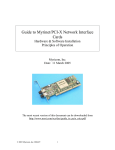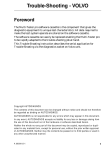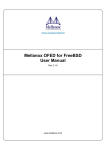Download Myricom Myrinet/PCI-X Network Interface Cards Specifications
Transcript
Guide to Myrinet/PCI Host Interfaces Hardware & Software Installation Principles of Operation Myricom, Inc. Date: 18 February 2002 The most recent version of this document can be downloaded from http://www.myri.com/scs/doc/guide_to_interfaces.pdf © 2002 Myricom, Inc. 1 Regulatory Information Electromagnetic Compatibility (EMC) Myrinet-Fiber (M3F), Myrinet-Serial (M3S), and Myrinet-LAN (M2L) host interfaces and their associated cables are fully compliant with the following standards and specifications for the emission of and susceptibility to electromagnetic interference (EMI): European Union ➢ BS EN55024 (1998) ➢ BS EN55022 (1998) Class A Australia/New Zealand AS/NZS 3548 (w/A1 & A2 1997) Class A using: ➢ BS EN55022 (1998) Class A United States FCC Part 15 Subpart B Class A using: ➢ FCC Part 15 Subpart B Section 15.109 Class A ➢ CISPR 22 (1997) Class A ➢ ANSI C63.4 (1992) method Canada ICES-003 Class A using: ➢ CISPR 22 (1997) Class A ➢ ANSI C63.4 (1992) method Japan VCCI (April 2000) Class A using: ➢ CISPR 22 (1997) Class A On the basis of these EMC certifications and other engineering data, these products carry the CE mark. A copy of the current Declaration of Conformity can be found linked from the product specifications linked from http://www.myri.com/myrinet/full_product_list/. Please note that Myrinet-SAN (M2M and M3M) host interfaces and their associated cables emit EMI in excess of Class A levels, and so should be used only for “in cabinet” applications. Laser Device Safety The optical-fiber transceivers used in the M3F-PCI64 family of products are Class I Laser Products. Optical-fiber components with this classification pose no threat of biological damage, and are considered to be safe. Disposal of Components that Contain Lead Myrinet host interfaces contain small quantities of lead in the tin-lead solder. Please dispose of them safely. Disposal of lead-containing electronic components through regular trash channels is prohibited in many countries and regions, because the lead leached out of landfills may contaminate groundwater supplies. Myricom has proper channels for the disposal of these materials, and will dispose of any Myrinet products returned for that purpose to Myricom. © 2002 Myricom, Inc. 2 Introduction Myricom currently produces two series of Myrinet/PCI host interfaces: the 64B series with 133MHz RISC and memory, and the 64C series with 200MHz RISC and memory. The product codes follow this scheme: Physical Port Form factor M3F- (Myrinet-Fiber) PCI M3S- (Myrinet-Serial) PMC M2M- or M3M- (Myrinet-SAN) M2L- (Myrinet-LAN) Interface type 64 64A 64B 64C Memory -2 -4 -8 such that, for example, an M3F-PCI64C-2 interface has a Myrinet-Fiber port, has the “PCI Short Card” form factor, is of the 64C type (Myricom LANai 9 processor operating at 200MHz), and has 2MB of local memory. Not all combinations are produced. The interfaces that are in current production are listed at: http://www.myri.com/myrinet/full_product_list.html This listing also includes prices and links to the detailed product specifications. PCI Short Cards The PCI short cards, as pictured below, are available with Myrinet ports for Myrinet-Fiber (industry-standard LC-connectorized 50/125 multimode fiber cables), Myrinet-Serial (industrystandard HSSDC copper cable), Myrinet-SAN (special “microstrip” multiconductor ribbon cable) connections, or legacy Myrinet-LAN (special DB-37-connectorized multiconductor shielded cables). PCI short card (PCI64B, fiber connector) © 2002 Myricom, Inc. 3 PCI Mezzanine Cards PCI mezzanine cards (PMC) (as pictured below) are available only with Myrinet-SAN connections. PCI mezzanine card (PMC64B) All of these 64/32-bit, 66/33MHz, Myrinet-2000/PCI interfaces (64A, 64B, and 64C) are “universal”. They function correctly in hosts with 32-bit or 64-bit PCI slots that are compliant with PCI specifications (version 2.2), with a 33–66MHz PCI clock, and with either 3.3V or 5V PCI-bus signal levels. (3.3V signaling is required for 66MHz PCI slots, but 33MHz PCI slots may use either 5V or 3.3V signaling.) Identification on each Myrinet/PCI interface Product code Serial number Ethernet MAC address The label on a Myrinet/PCI interface © 2002 Myricom, Inc. 4 A label similar to that above appears on any Myrinet/PCI interface. This label contains the product code, the serial number, and the Ethernet MAC address. Please provide this information in any correspondence with Myricom support ([email protected]). Installation As a first step in using Myrinet technology, you must install the Myrinet/PCI interfaces into your hosts. Installation instructions vary depending on the characteristics of your host: (1) tower unit host, (2) rack-mounted host, or (3) PCI mezzanine motherboard. If you have (1) or (2), you will use PCI short cards, and if you have (3), you will use PCI mezzanine cards (PMC). The interfaces should be handled gently, preferably by the front panel or card edges. The front panel of the interface is the metal plate or molding (as can be seen on the photos above) that contains two LEDs and the port connector. Directions for installation are as follows: Step 1: Power off the host to which you will be installing the card(s). Remove the exterior covering of the machine, and locate the PCI slot(s). Case 1: Tower unit host If you have a tower unit host, the PCI slots will look something like the following: PCI slots (32-bit and 64-bit) In this photo the PCI slots are the white connectors. There are four 32-bit PCI slots and two (longer) 64-bit PCI slots. © 2002 Myricom, Inc. 5 Case 2: Rack-mounted host If you have a rack-mounted machine, the PCI slots will look something like the following: PCI slots (64-bit and 32-bit) In this photo the PCI slots are the white connectors. There are two 64-bit PCI slots and four 32-bit PCI slots. Case 3: PCI mezzanine motherboard If you have a PCI mezzanine motherboard, then the PCI slot should look something like the following: Photo of PCI mezzanine slot © 2002 Myricom, Inc. 6 where you can see a previously installed Myrinet/PMC interface to the left of the circled PMC connectors. 64-bit PMC slots or cards have three connectors, as shown. 32-bit PMC slots or cards have just two connectors. It is alright to plug a 64-bit card (PMC64A, PMC64B, or PMC64C) into a 32-bit slot, or a 32-bit card (PMC32A, PMC32B, PMC32C) into a 64-bit slot, but in either case the card will function as a 32-bit interface. Step 2: Insert the Myrinet/PCI interface into a PCI slot. Case 1: Tower unit host With a tower unit host, a PCI-short-card interface is installed vertically in a PCI slot. Any of the PCI slots could be chosen for the installation of the Myrinet/PCI interface. However, for best performance, a 64-bit interface should be installed in a 64-bit PCI slot. Inasmuch as some PCI connectors are more close-fitting than others, you may need to push quite hard on the front panel and the edge of the card to seat the card securely. Inserting a PCI-short-card interface vertically © 2002 Myricom, Inc. 7 Installed interface in a 64-bit PCI slot Case 2: Rack-mounted host Since space is very restricted in a rack-mounted unit, the Myrinet/PCI interface must be installed with a riser card. The riser card is inserted on the PCI connector side of the card, and the riser card is then inserted into a PCI slot (as shown in the following photograph). Inasmuch as some PCI connectors are more close-fitting than others, you may need to push quite hard on the front panel and the edge of the card to get the card to seat securely. Insertion of interface (with riser card) into a 64-bit PCI slot © 2002 Myricom, Inc. 8 Caution: Although PCI riser cards are commonly used, they will generally violate PCI specifications for the length of signal traces. A riser card may also introduce impedance discontinuities and signal degradation between the mother board, riser card, and interface card. If you observe PCI-communication errors when using a riser card, see if the problem persists when you plug the Myrinet/PCI interface directly into the PCI slot. A higher quality riser card -- one whose traces match the impedance of signals on the mother board and interface -may also solve the problem. Also, it is important that a 64-bit riser card be used in a 64-bit PCI slot, and likewise a 32-bit riser card should be used in a 32-bit PCI slot. Otherwise, the Myrinet/PCI interface will not be correctly detected and/or serious performance irregularities will result. Any of these PCI slots could be chosen for the installation of your Myrinet/PCI interface. However, for best performance, a 64-bit interface should be installed into a 64-bit PCI slot. Installed interface (with attached riser card) © 2002 Myricom, Inc. 9 Case 3: PCI mezzanine motherboard Insert the Myrinet/PMC interface horizontally into the two or three PCI slots on the motherboard. Inserting a PMC interface Note: Inserting a 64-bit interface into a 32-bit PCI slot As previously mentioned, it is possible to install a 64-bit Myrinet/PCI interface into a 32bit PCI slot, as shown below. A 64-bit Myrinet/PCI card in a 32-bit PCI slot © 2002 Myricom, Inc. 10 However, if this is done, the data path is 32 bits, and the 64-bit interface will be able to transfer data only at half the data rate of a 64-bit slot. Step 3: Secure the card in place with a locking screw (if applicable), replace the exterior cover of the host, and attach the cable (Fiber, Serial, or SAN) between the card and the switch (as detailed on pages 3-4 of the document “Guide to Myrinet-2000 Switches and Switch Networks,” available at http://www.myri.com/myrinet/m3switch/guide/index.html). Please follow the instructions in the “Guide to Myrinet-2000 Switches and Switch Networks” when connecting/disconnecting cables to/from cards and switches. Step 4: Power on the host and check that the card is detected by the host operating system. Depending upon the operating system running on the host, this detection mechanism varies. © 2002 Myricom, Inc. 11 Linux If your host is running Linux, you can issue the command /sbin/lspci, which will return all devices attached to the PCI bus. Screen image of /sbin/lspci command. If the output you receive is similar to that above, namely you see the “MYRICOM Inc” entry, the Myrinet/PCI interface has been correctly detected, and you can now proceed to installing software. Refer to the “Guide to Software” for details of the required software and for installation instructions. © 2002 Myricom, Inc. 12 Solaris If your host is running Solaris, you can issue the command /usr/sbin/prtconf, which will print the system configuration. Screen dump of /usr/sbin/prtconf command If the output you receive is similar to that above, namely you see the “MYRICOM” entry, the Myrinet/PCI interface has been correctly detected, and you can now proceed to installing software. Refer to the “Guide to Software” for details of the required software and for installation instructions. © 2002 Myricom, Inc. 13 Tru64 If your host is running Tru64, prior to booting the machine, or after halting the operating system, at the SRM console prompt, type show conf Screen dump of show conf command In Slot 13, under “Option” you will see 804314C1. This field contains the card ID, 8043, for the Myrinet/PCI interface, and the card vendor ID for Myricom, 14C1 (as listed in the PCI Vendor registry). If the output you receive is similar to that above, the Myrinet/PCI interface has been correctly detected, and you can now proceed to installing software. Refer to the “Guide to Software” for details of the required software and for installation instructions. © 2002 Myricom, Inc. 14 FreeBSD If your host is running FreeBSD, you can issue the command /usr/sbin/pciconf -l. Screen dump of /sbin/pciconf –l command The third column gives the contents of the subvendor id register. The field consists of the card ID in the upper half of the value and the card vendor ID in the lower half of the value. The card ID for the Myrinet/PCI interface is 8043, and the vendor ID for Myricom (as listed in the PCI Vendor registry) is 14c1. If the output you receive is similar to that above, the Myrinet/PCI interface has been correctly detected, and you can now proceed to installing software. Refer to the “Guide to Software” for details of the required software and for installation instructions. © 2002 Myricom, Inc. 15 IRIX If your host is running IRIX, you can issue the command /sbin/hinv –v –c iobd. Screen dump of /sbin/hinv command The PCI adapters with vendor ID 5313 are Myrinet/PCI interfaces. If the output you receive is similar to that above, the Myrinet/PCI interface has been correctly detected, and you can now proceed to installing software. Refer to the “Guide to Software” for details of the required software and for installation instructions. © 2002 Myricom, Inc. 16 MacOS X If your host is running MacOS X, you can issue the command ioreg, which will return all devices attached to the PCI bus. An excerpt of the sample output is as follows: <…> || || || || | +-o USBKeyLargo <class USBKeyLargo> +-o pci14c1,8043@12 <class IOPCIDevice> | +-o gm <class gm> +-o usb@18 <class IOPCIDevice> <…> If the output you receive contains the “8043” device, the Myrinet/PCI interface has been correctly detected, and you can now proceed to installing software. Refer to the “Guide to Software” for details of the required software and for installation instructions. © 2002 Myricom, Inc. 17 Windows 2000 and Windows NT For Windows 2000 and Windows NT, a “Found New Hardware” dialog box (as shown below) will appear when the host detects a new PCI card. Once a Myrinet/PCI interface has been installed and the host powered on, the appearance of this dialog box will signal that Windows has detected the interface card. Photo of Dialog Box © 2002 Myricom, Inc. 18 Principles of Operation As illustrated in the following block diagram, all Myrinet/PCI interfaces include a RISC processor to execute the Myrinet Control Program (MCP), local memory, a packet interface to and from the Myrinet port, and a versatile DMA controller to support zero-copy APIs. Each of these parts support high-availability and data-integrity features, such as “heartbeat” linkcontinuity monitoring, packet checksums, and memory parity. The difference between the PCI64B and PCI64C interfaces is the allowed clock rate of the RISC and local memory: 133MHz for the PCI64B, and 200MHz for the PCI64C. The difference between the Fiber, Serial, and SAN interfaces is in the conversion circuitry between the SAN port of the LANai chip and the external port. For the Fiber (M3F) interface pictured and shown in the block diagram, the conversion circuitry consists of a SerDes-SAN chip, a SerDes (Serializer-Deserializer) chip, and the Fiber transceiver. SerializerDeserializer (SerDes) SerDes-SAN LANai Memory Power regulator PCI64B card LEDs © 2002 Myricom, Inc. Fiber connector PCI-DMA 19 PCI connector The front panel of the PCI-Short-Card interface pictured above is the vertical metal plate on the left-hand side of the interface. Two LEDs and the cable connector penetrate this PCI front panel (also known as a face plate). For the PCI mezzanine cards (pictured below), the two LEDs are on either side of the SAN cable connector. PCI Mezzanine connectors Yellow LED SAN connector Green LED PCI64B PMC interface The LEDs have the same functions for PCI-Short-Card (PCI) and PCI-Mezzanine-Card (PMC) interfaces. For Fiber (M3F) and Serial (M3S) interfaces, the green “link” LED will illuminate when the board is powered, the firmware (such as the GM Myrinet Control Program) is loaded, and the link is active. These conditions are satisfied by a port being plugged through a cable to a powered switch, to another initialized interface or to a loopback plug. The green LED blinks at up to ~5Hz to show when packet traffic is flowing through the port. The green LEDs on Myrinet-2000 switches operate similarly. For Myrinet-SAN (M2M/M3M) interfaces, the behavior of the green “link” LED is the same as for Fiber and Serial ports if the high-availability (HA) features are enabled in the MCP. (The LED operates from the detection of link continuity using the presence of the HA BEAT control symbol on the link.) If the HA features are disabled, the link LED of a SAN port will be on even without a cable or loopback plug connected to the port. The yellow “LANai” LED is controlled by the LANai processor, and its meaning may be different for different Myrinet Control Programs. For the GM MCP, the yellow LED will pulse like a heartbeat while the MCP is running, and will pulse faster when there is more packetsending activity (including sending acknowledge packets in reply to packets received.) If the yellow LED is not pulsing, the GM MCP is not loaded or is not running. It is safe electrically to plug or unplug the interface from the switch while the host is powered on. However, if you unplug the cable and plug it into another port on the switch or into a different © 2002 Myricom, Inc. 20 interface, the topology of the network changes, and the routes would need to be updated by the GM mapper (see “Guide to Software”). A summary of the specifications of the PCI64B and PCI64C Myrinet/PCI interfaces is listed below: PCI-bus Interface: 64/32-bit, 66/33MHz, supports all burst modes and write-invalidate, master or slave. These interfaces are capable of sustained PCI data rates approaching the limits of the PCI bus (528 MB/s for 64-bit, 66MHz; 264 MB/s for 64-bit, 33MHz or 32-bit, 66MHz; 132 MB/s for 32-bit, 33MHz). However, the data rate to/from system memory will depend upon the host’s memory and PCI-bus implementation. The achievable performance can vary greatly from one host PCI chipset to another. These interfaces function correctly in all PCI slots that are compliant with PCI specifications version 2.2 or later, with either 3.3V or 5V PCIbus signal levels. (3.3V signaling is required of 66MHz PCI slots, but 33MHz PCI slots may use either 5V or 3.3V signaling.) PCI parity generation and detection is provided. The interface provides a 64-bit Base Address Register (BAR), but will also function properly when programmed with a 32-bit address, per the PCI specifications. DMA controller: DMA stands for Direct Memory Access. In order to support zero-copy APIs efficiently, the DMA operations can be performed with arbitrary byte counts and byte alignments. The DMA controller computes the IP checksum for each transfer. The DMA controller also provides a “doorbell” signaling mechanism that allows the host to write anywhere within the doorbell region, and have the address and data stored in a FIFO queue in the local memory. The DMA controller traverses multiple lists in the interface’s local memory to initiate DMA transfers, thus allowing multiple pending DMA operations. Interface processor: LANai 9 RISC operating at up to 133MHz for the PCI64B interfaces, or at up to 200MHz for the PCI64C interfaces. Note: the RISC core in the LANai 9 is similar to but not binary-compatible with earlier LANai RISCs. Local memory: 2MB (256Kx8B) in the –2 version; 4MB (512Kx8B) in the –4 version, 8MB (1Mx8B) in the –8 version. (The –4 and –8 options are not currently available for all port types and for PMC versus PCI form factors.) The local memory operates from the same clock as the RISC, i.e., at up to 133MHz for the PCI64B interfaces, or at up to 200MHz for the PCI64C interfaces. Up to 1,067 MB/s (PCI64B) or 1,600 MB/s (PCI64C) of memory bandwidth is available to support the Myrinet port, the host DMA, and the RISC processor. Byte parity is generated and checked. The standard 2MB of local memory is sufficient for most applications. Myrinet-2000-Fiber port: 2.0+2.0 Gb/s. An “LC” optical connector attaches to a fiber pair up to 200m of 50/125 multi-node fiber. This is a Class I Laser Product (no biological hazard). © 2002 Myricom, Inc. 21 Myrinet-2000-Serial port: 2.0+2.0 Gb/s at an HSSDC connector to a Myrinet Serial-Link cable up to 10m in length. Myrinet-2000-SAN port: The default data rate can be switched between SAN-2000 (2.0+2.0 Gb/s) and SAN-1280 (1.28+1.28 Gb/s) with a mechanical switch on the circuit board. The host can over-ride the default data rate. The SAN port appears on the A link of the SAN connector (refer to http://www.myri.com/myrinet/cables/m2m-cl.html for details); the B link is unused. PCI Short card (switch positioned for SAN-2000 rate) PCI Mezzanine card (switch positioned for SAN-2000 rate) Physical dimensions: PCI Short Card: height 10.7cm, length 18.0cm, total thickness 2.5cm, weight 120g. Power (PCI Short card): The interface is powered from the 5V PCI power: 1.9A (9.5W) maximum for the M3F-PCI64B-2; 2.2A (11.0W) maximum for the M3F-PCI64C-2. Power (PCI Mezzanine card): The interface is powered from the 3.3V PCI power: ~4 Watts. PCI Mezzanine Card (IEEE P1386.1). Regulatory Approvals for the M3F- and M3S interfaces: Please see page 2. Performance differences between PCI64B and PCI64C Refer to http://www.myri.com/myrinet/performance/index.html for full details on the application-level performance difference between the PCI64B and PCI64C interfaces. Software Requirements All Myricom software support for the PCI64 family of interfaces is based on the GM Myrinet Control Program and the GM API. For details about GM, please refer to “The GM Message Passing System” document available at http://www.myri.com/scs/GM/doc/gm_toc.html. Refer to the “Guide to Software” for details of the available software and for installation instructions. The MyriAPI software is not available for the PCI64 family of interfaces. © 2002 Myricom, Inc. 22






























